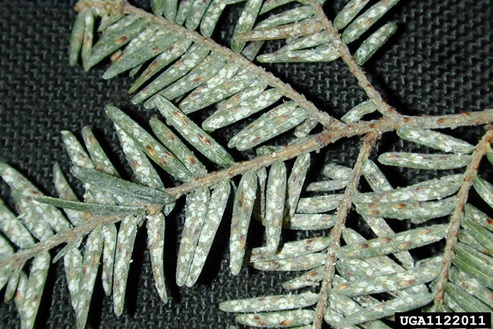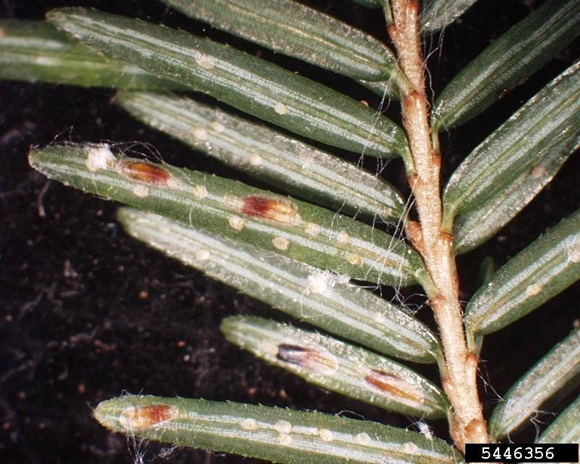Dealing with Elongate Hemlock Scale
ENTFACT-471: Dealing with Elongate Hemlock Scale | Download PDF
Jonathan L. Larson, Extension Entomologist
University of Kentucky College of Agriculture
Fast Facts
- Elongate hemlock scale is an armored scale pest that can be found feeding on hemlocks, firs, spruce, pines, and yews.
- Female scales have an oblong orange-brown coating, they are longer than they are wide. Males are smaller, with a white coating.
- Symptoms of this pest include yellowed needles, needle loss, and branch dieback on infested evergreens. Mortality can occur with high populations.
- Management can depend on crawler control using contact insecticides or organic options like horticultural oil or insecticidal soap or can rely on a systemic treatment of dinotefuran.
Potential Hosts
Elongate hemlock scale (EHS) is an invasive species best known for infesting hemlocks. EHS will also feed on cedars, Douglas firs, pines, and yews. These hosts are usually infested after nearby hemlocks have been infested. Notably, this pest may impact the ability to produce fir trees for Christmas tree markets.

Symptoms and Pest Description
Elongate hemlock scale causes discoloration to infested needles. Light yellow spots or bands may appear when an infestation is small and progress to total yellowing as the population rises. As males grow, their white coverings may also cause heavily infested areas to be appear grey or off-color. This species is typically found on the undersides of infested needles. As the scales feed, they may induce needle loss and branch dieback and if left unchecked, possible mortality. Affected plants may also have thin canopies.
The bodies and waxy coverings of adult elongate hemlock scales are longer than they are wide. There are some key differences between females and males. The females are about 1/20th inch long when fully grown and the waxy cover that envelops them is orange-brown to brown. If you peel the waxy cover off of the insect, you will find a small yellow colored bug underneath. Males are smaller than females and have white, waxy covers. Males will eventually mature into winged adults that can fly around to mate with females. The small, six legged, immatures that emerge from eggs are known as crawlers and are yellow.

Life Cycle in Kentucky
Elongate hemlock scale is known to overwinter as either a fertilized female or as eggs on host trees. This is important as eggs can begin to hatch in spring (usually in May) and females may start slowly laying eggs as well. This results in an extended period of time when newly emerged scale crawlers can be active and all life stages may be present at once on an infested plant.
Once mature, these scales will mate in mid-summer to produce the generation that will overwinter.
Management
Management can depend on targeting scales through a systemic insecticide application or by targeting the crawlers with growth regulators or contact insecticides.
Dinotefuran, a systemic neonicotinoid insecticide can be applied to foliage or as a basal trunk spray to manage EHS populations. Applications should be made from May into the fall. Imidacloprid, another commonly used systemic insecticide, will not be effective against this pest.
Crawlers can be treated with multiple contact insecticide products such as bifenthrin or horticultural oils. These will kill scales but will likely need multiple applications from June into September. Reapplication must follow label directions for intervals between treatments. Buprofezin, an insect growth regulator can also target crawlers. To maximize its impact, make applications when crawler populations are at their highest level from May into July.
CAUTION! Pesticide recommendations in this publication are registered for use in Kentucky, USA ONLY! The use of some products may not be legal in your state or country. Please check with your local county agent or regulatory official before using any pesticide mentioned in this publication. Of course, ALWAYS READ AND FOLLOW LABEL DIRECTIONS FOR SAFE USE OF ANY PESTICIDE!
03/25 (Issued)
